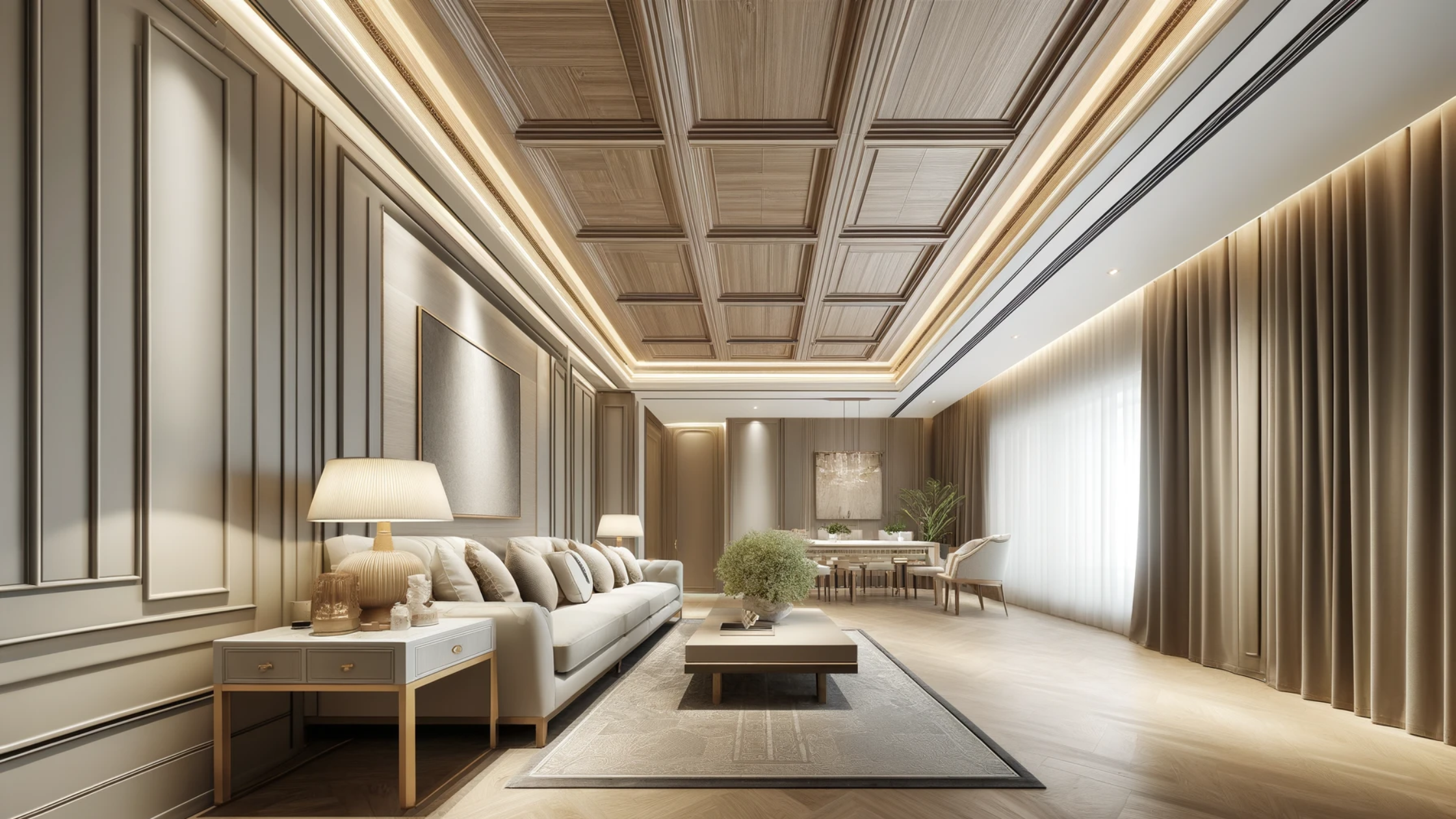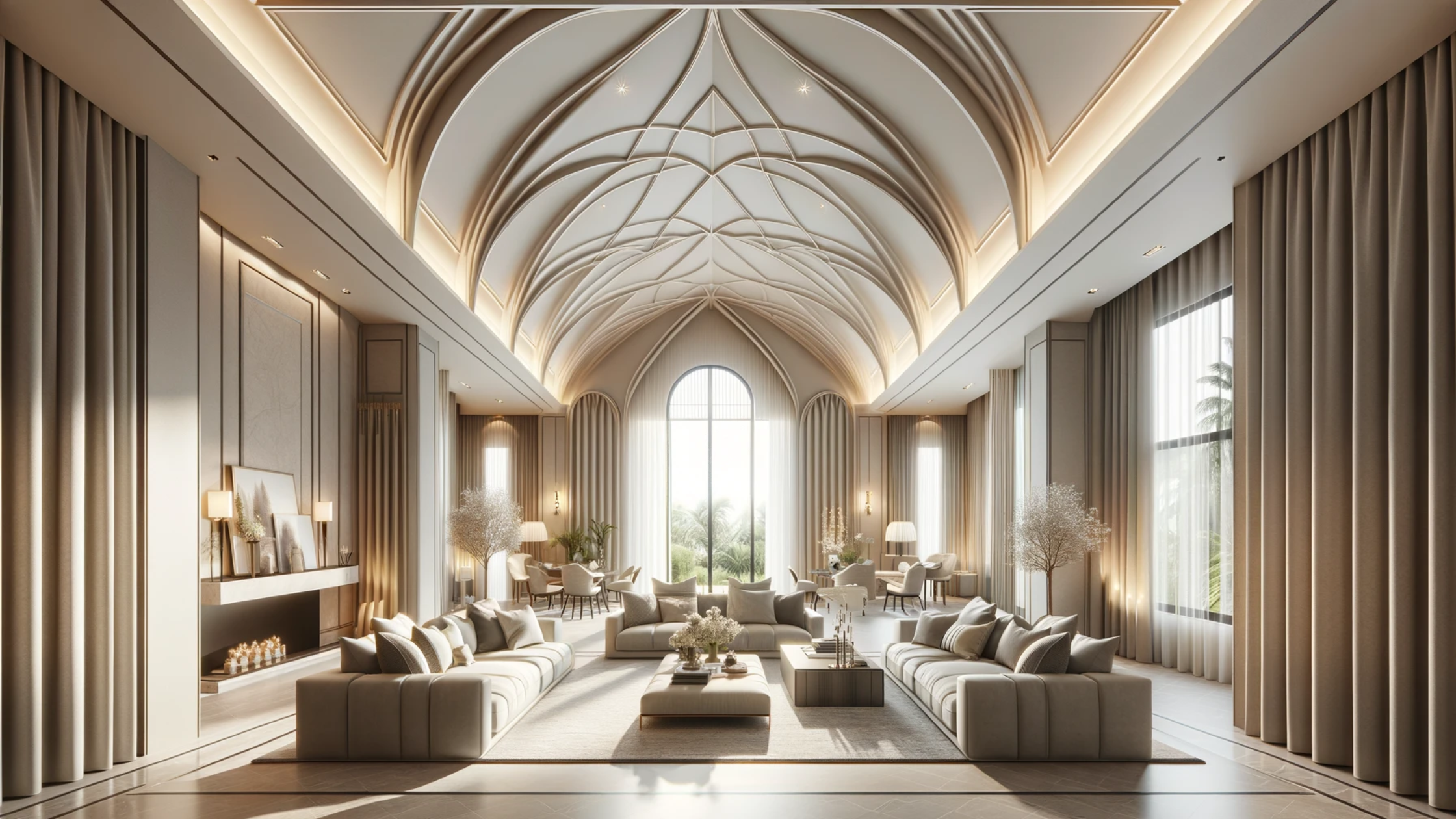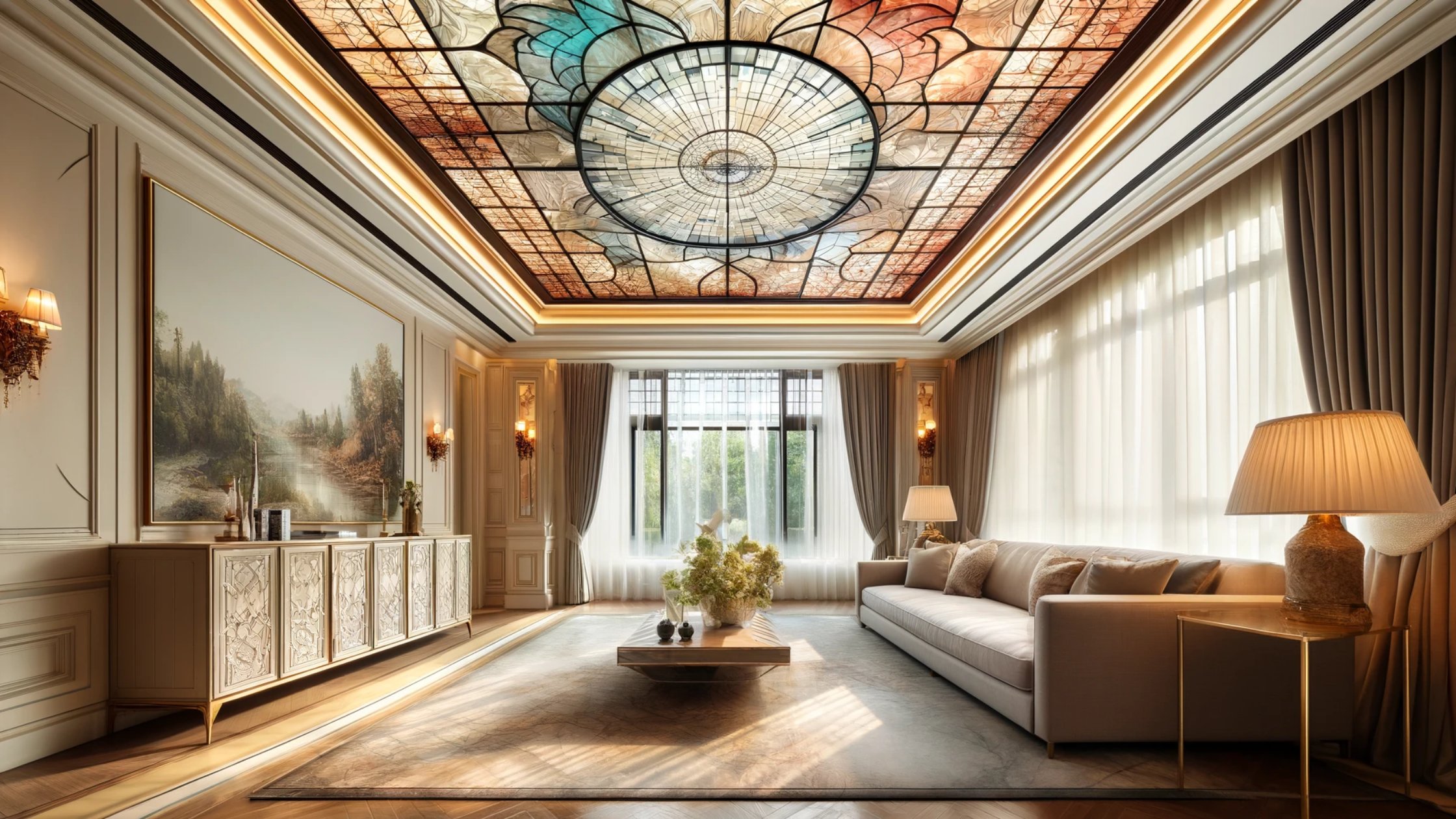
If the sky is a beautiful canvas we look up to when we are outdoors, why should our homes lack the opportunity to have ceilings that similarly inspire us? Ceiling design has the power to radically change environments when used in the right way. Designers are now focusing on the need to explore beyond false ceilings and create newer ways of artistic living.

Importance of Ceiling Design
Let us first explore why we need ceiling design for our interiors and its impact on our daily lives.
Visual Impact: Ceiling design contributes significantly to the overall aesthetics of a room, enhancing its visual appeal and creating a cohesive design scheme.
Room Atmosphere: The design of the ceiling can influence the perceived atmosphere of a space, whether it’s cozy and intimate or open and airy.
Spatial Perception: Well-designed ceilings can alter the perception of space, making rooms appear larger, taller, or more intimate depending on the design choices.
Architectural Character: Ceilings provide an opportunity to add architectural interest and character to a room, enhancing its uniqueness and style.
Lighting Integration: Ceilings play a crucial role in lighting design, allowing for the integration of various lighting fixtures to create ambiance and functionality.
Functional Considerations: Beyond aesthetics, ceiling design addresses practical aspects such as acoustics, ventilation, and insulation, contributing to the comfort and functionality of interior spaces.

Innovative False Ceiling Design Ideas
First, one has to also acknowledge the functionality and accessibility of false ceilings and how they can also be used creatively in ceiling design.
Multi-Level False Ceilings
Create visual interest and depth by incorporating multiple levels or layers into the false ceiling design. Varying heights and shapes can add architectural drama and complexity to the space, making it feel more dynamic and spacious.

Curved and Organic Shapes
Move away from traditional straight lines and angles by introducing curved or organic shapes into the false ceiling design. Curved elements can soften the overall aesthetic of the space and create a more fluid and inviting atmosphere.

Integrated Lighting Solutions
Use the false ceiling as a platform to integrate innovative lighting solutions such as LED strips, recessed lights, or pendant fixtures. Strategic placement of lighting elements can enhance the ambiance of the room, highlight architectural features, and create focal points.

Textured Ceiling Design
Experiment with textured finishes such as wood, metal, or plaster to add tactile interest to the false ceiling. Textured surfaces can create visual depth and dimension, adding warmth and character to the space.

Artistic and Customised Designs
Embrace creativity and individuality by commissioning custom-designed false ceilings that reflect your personal style and preferences. Whether it’s a mural, pattern, or artistic installation, custom designs can make a bold statement and become a focal point of the room.

Natural Elements and Biophilic Design
Bring elements of nature indoors by incorporating natural materials such as wood, bamboo, or greenery into the false ceiling design. Biophilic elements can enhance well-being, connect occupants with the natural world, and create a sense of harmony and tranquility.

Smart Technology Integration
Explore the integration of smart technology features into the false ceiling, such as built-in speakers, sensors, or smart home controls. These features can enhance convenience, comfort, and energy efficiency while adding a touch of modernity to the space.
Beyond False Ceilings
While false ceilings are one of the most common ways of elevating ceiling design, there are a multitude of diverse alternatives that can be used to make your spaces even more artistically rich and vibrant.
Exposed Beams and Rafters
Exposed beams and rafters bring a rustic, natural charm to interior spaces. Instead of concealing structural elements, they celebrate them, adding architectural interest and texture. These elements can be made of wood, metal, or even faux materials, depending on the desired aesthetic. Exposed beams can create a sense of warmth and coziness in a room, while rafters add a touch of industrial or farmhouse-style elegance.

Coffered Ceiling Design
Coffered ceilings feature a series of recessed panels or coffers, often adorned with molding or trim, creating a sophisticated and elegant look. These ceilings add depth and dimension to a room while evoking a sense of grandeur. Coffered ceilings are versatile and can be customized to suit various architectural styles, from traditional to contemporary. They can also incorporate lighting fixtures within the recessed panels, enhancing both ambiance and functionality.

Tray Ceilings
Tray ceilings, also known as recessed ceilings or inverted ceilings, feature a central section that is elevated or recessed relative to the surrounding perimeter, creating a tray-like effect. This design adds visual interest and depth to a room, making it feel more spacious and dynamic. Tray ceilings can be simple or ornate, depending on the desired aesthetic. They offer an opportunity to incorporate architectural details, such as crown moulding or indirect lighting, further enhancing their appeal.

Vaulted Ceiling Design
Vaulted ceilings feature angled or curved surfaces that rise toward the center of the room, creating a dramatic and expansive feel. These ceilings are typically found in cathedral-style or loft spaces and can vary in slope and height. Vaulted ceilings add architectural drama and can make a room feel larger and more open. They also provide opportunities for creative lighting design and can accommodate large windows or skylights, maximizing natural light and ventilation.

Stained glass ceilings
Incorporating stained glass into ceilings or roofs can create breathtaking and unique design elements within interior spaces. Traditionally associated with windows in religious buildings or historic homes, stained glass has evolved to become a versatile medium for interior design, including ceilings. Stained glass allows natural light to filter through, creating a dynamic interplay of colours and patterns as sunlight passes through the glass.

Ceiling Design for Living Rooms
Living rooms are one of the most common muses of interior designers as they usually are the space for gatherings, discussions, parties and so on. Innovative ceiling design for living rooms is something that most people look for in interior design.
Here are some creative ways to elevate your living room spaces:
Statement Ceilings
Statement ceilings serve as focal points in the living room, drawing the eye upward and adding visual interest to the space. Consider bold design choices such as vibrant colors, intricate patterns, or striking textures to make a statement. Wallpaper, stenciling, or mural painting can create dramatic effects, while coffered or tray ceilings add architectural detail. Incorporating statement lighting fixtures, such as chandeliers or pendant lights, further emphasizes the impact of the ceiling design.

Materials and Finishes for Ceiling Design
The choice of materials and finishes can dramatically impact the look and feel of living room ceilings. Consider using natural materials such as wood or bamboo for a warm and inviting atmosphere, or opt for sleek metal finishes for a modern, industrial vibe. Textured finishes such as plaster or faux finishes add depth and dimension to the ceiling, while glossy surfaces reflect light and create a sense of openness. Experiment with unconventional materials like glass or acrylic for a contemporary twist on traditional ceiling design.

Open Concept Ceilings
Open concept ceilings blur the boundaries between living spaces, creating a sense of continuity and flow throughout the home. Removing ceiling partitions or incorporating visual elements such as arches or skylights can create an open and airy feel, perfect for modern living. Consider using ceiling beams or columns to define separate areas within the living room while maintaining an overall sense of openness. Open concept ceilings encourage interaction and conversation, making them ideal for social gatherings and family gatherings.

Implementing Creative Ceiling Designs
Collaboration with Design Professionals
Before starting any ceiling design project, consult with design professionals such as architects or interior designers to discuss your goals, preferences, and budget. Design professionals can provide valuable insights, creative ideas, and technical expertise to help bring your vision to life. They can also offer guidance on structural considerations, building codes, and permits required for the project.
Budgeting and Cost Considerations
Determine your budget for the ceiling design project early on and be realistic about what you can afford. Consider factors such as materials, labour costs, permits, and any unexpected expenses that may arise.
Prioritize Needs vs. Wants
Identify your priorities and allocate your budget accordingly. Focus on essential elements of the ceiling design that align with your vision and functional requirements, and be prepared to make trade-offs or adjustments to stay within budget.

Research Cost of Ceiling Design
Research the costs of materials, labour, and other expenses associated with the project to get a realistic sense of what to expect. Obtain multiple quotes from contractors or suppliers to compare prices and negotiate favourable terms.
Plan for Contingencies
Set aside a contingency fund to cover unforeseen expenses or changes to the project scope. Having a buffer in your budget can help mitigate financial stress and ensure that the project stays on track.
DIY Options and Resources
Assess your skills and resources. Determine whether you have the necessary skills, tools, and resources to tackle certain aspects of the ceiling design project yourself. Be honest about your abilities and limitations to avoid costly mistakes or safety hazards.
Start Small. If you’re new to DIY projects, start with smaller-scale projects or simple techniques to gain confidence and experience before tackling more complex tasks. Practice proper techniques and safety procedures to ensure successful outcomes.
In this way, planning a design strategy beforehand is imperative. To find out more about ceiling design that suits your needs, visit our website or contact us.

Frequently Asked Questions (FAQs)
Is a false ceiling my only option for enhancing interior design?
- No, false ceilings are just one option among many for improving interior aesthetics. There are various innovative ceiling designs that can add style, functionality, and personality to your space without resorting to false ceilings.
What are some alternatives to false ceilings?
- Alternatives to false ceilings include exposed beams and rafters, coffered ceilings, tray ceilings, vaulted ceilings, and suspended ceilings.
- These options offer unique aesthetic appeal and can complement different interior styles.
How can ceiling design contribute to expanding interior spaces?
- Ceiling design can impact the perception of space within a room. By incorporating techniques such as lighting integration, multi-level ceilings, or open concept designs, you can create the illusion of a larger and more expansive interior environment.
What are some creative ceiling design ideas for living rooms?
- Creative ceiling design ideas for living rooms include statement ceilings, lighting integration, architectural features, unique materials and finishes, and open concept ceilings.
- These elements can add visual interest, enhance ambiance, and elevate the overall design of the space.
Are there DIY options for implementing creative ceiling designs?
- Yes, there are DIY options for implementing certain aspects of ceiling designs, such as painting, installing lighting fixtures, or adding decorative elements.
- However, more complex projects may require professional interior design consultants to ensure proper installation and safety compliance.
Recent Posts
- Luxury Kitchens: The Perfect Balance of Aesthetics and Functionality
- Feature Walls: Adding Character to Your Interiors
- A Guide for Creating Cosy Interiors
- Ensuring Sustainability While Maintaining Luxury in Interior Design
- From Quartz to Velvet: A Guide to Interior Design Accessories and Exquisite Finishes
Recent Comments
Tags Cloud
Categories
- Architecture 28
- Experiences 7
- Home style 37
- Inspirations 13
- Interior 38
- Modern 28
- Others 3
- Reviews 3
- Tips 4
- Uncategorized 1
Search
CATEGORIES
- Architecture 28
- Experiences 7
- Home style 37
- Inspirations 13
- Interior 38
- Modern 28
- Others 3
- Reviews 3
- Tips 4
- Uncategorized 1










